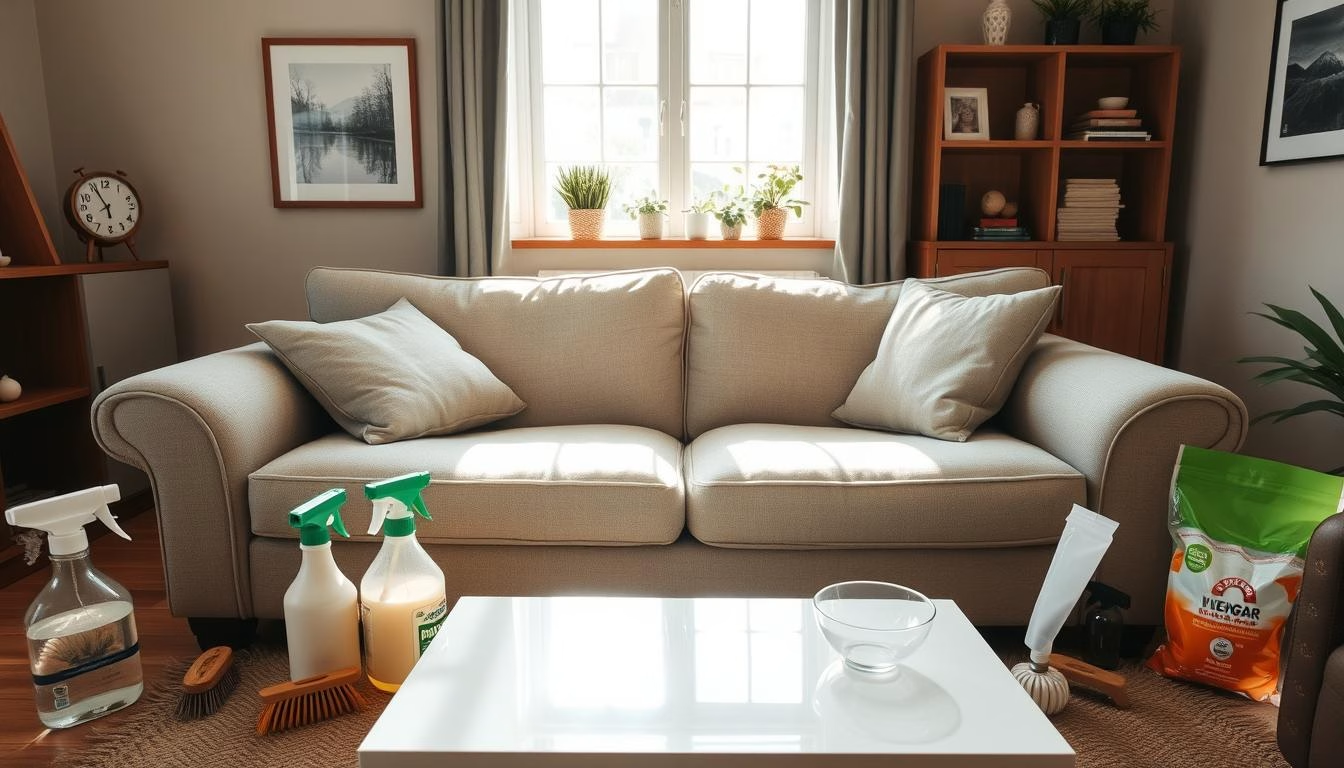Did you know the average American household spends over $350 a year on professional couch cleaning? But, you can save money and clean your couch at home with simple homemade solutions. This article will show you the best DIY couch cleaner recipes, how to clean your couch, and tips to keep it looking new.
Key Takeaways
- Discover cost-effective DIY couch cleaner recipes using everyday household ingredients
- Learn how to clean different couch fabric types and address common stains
- Understand the benefits of natural, eco-friendly cleaning solutions for your home
- Gain insights on professional couch cleaning services vs. DIY methods
- Explore practical tips to prevent future stains and maintain your couch’s appearance
Understanding Different Couch Fabrics and Their Cleaning Requirements
Keeping your sofa cleaner or upholstery cleaner in top shape means knowing how to clean each couch fabric. Each fabric type needs a special cleaning method to keep it looking great. This ensures the fabric stays in good condition.
Natural vs. Synthetic Fabric Care
Natural fabrics like cotton, linen, and wool need gentle care. They can shrink, fade, or get damaged by strong cleaners or too much rubbing. On the other hand, synthetic fabrics like polyester, nylon, and microfiber can handle tougher cleaning.
Reading Fabric Care Labels
Always check the fabric care label before cleaning your sofa cleaner or upholstery cleaner. The label tells you the best way to clean, the right temperature, and any special tips. This helps keep the fabric looking good for longer.
Material-Specific Cleaning Considerations
- Cotton and linen: Use gentle detergents, warm water, and air-dry them.
- Wool: It’s best to use dry cleaning or special wool cleaners to prevent shrinkage.
- Microfiber: Clean with a mild, water-based solution and avoid rough scrubbing.
- Leather: Use leather-specific cleaners and conditioners to keep it soft and shiny.
Knowing how to clean each couch fabric ensures your sofa cleaner or upholstery cleaner works well. This way, your furniture stays beautiful and lasts longer.
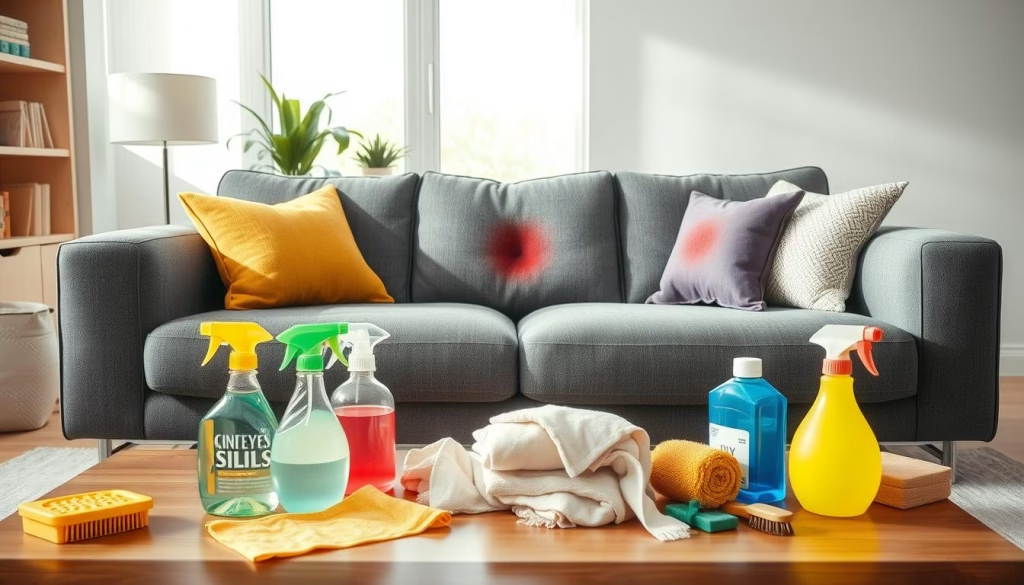
“Proper fabric care is the key to maintaining the pristine condition of your couch for years to come.”
Essential Ingredients for Homemade Couch Cleaner
Cleaning your couch at home doesn’t have to cost a lot. You can use common household items to make effective couch cleaner solutions. Knowing what each ingredient does helps you make DIY cleaners that fit your couch’s needs.
Here are some key ingredients for a homemade couch cleaner:
- Vinegar – It’s a natural disinfectant and deodorizer. Vinegar can remove grease, lift stains, and make your couch smell fresh.
- Baking Soda – It’s a gentle scrubber for dirt and grime without harming your couch. It also gets rid of bad smells, leaving your furniture smelling clean.
- Castile Soap – This plant-based soap cuts through grease and removes tough stains without damaging your couch’s fabric.
- Essential Oils – Adding a few drops of essential oils like lemon, lavender, or tea tree can make your cleaner smell good and work better.
Mixing these ingredients in the right way makes a custom, eco-friendly couch cleaner. It will make your furniture look and smell great.
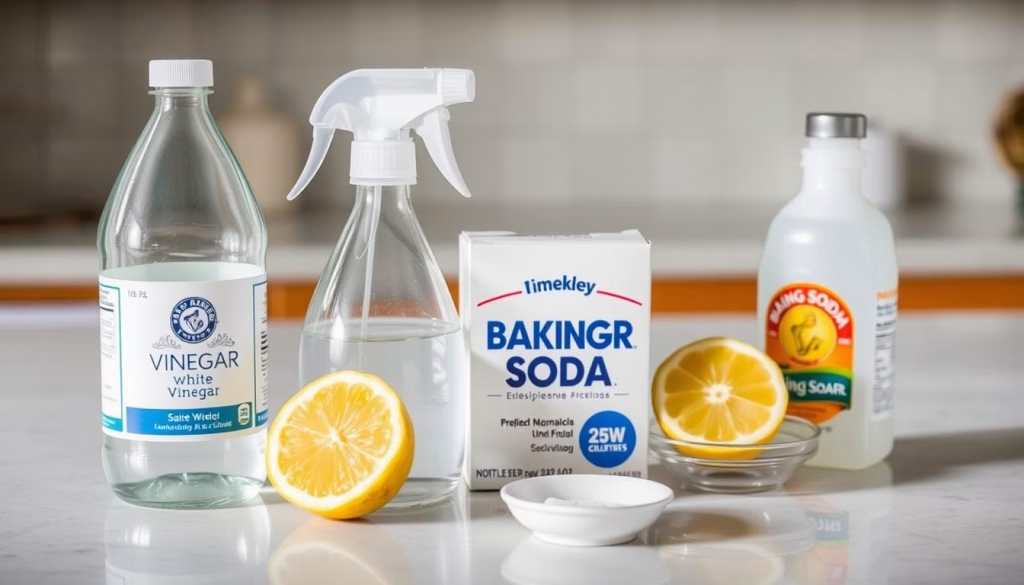
| Ingredient | Cleaning Properties | Best for Tackling |
|---|---|---|
| Vinegar | Disinfectant, deodorizer | Grease, stains, odors |
| Baking Soda | Gentle abrasive, odor absorber | Dirt, grime, odors |
| Castile Soap | Grease-cutting, gentle | Stubborn stains |
| Essential Oils | Aromatherapy, enhanced cleaning | Freshness, disinfection |
Natural DIY Upholstery Cleaning Solutions
Keeping your couch clean is key, but upholstery cleaners can be pricey. They also might have harsh chemicals. Luckily, there are natural DIY options that clean your couch shampoo well and save money.
Vinegar-Based Cleaners
Vinegar is a great, cheap cleaner for upholstery. Mix equal parts white vinegar and water in a spray bottle. Use it to spot-clean stains or lightly mist your couch.
The vinegar’s acidity breaks down dirt and grime. This leaves your couch smelling fresh and looking clean.
Baking Soda Solutions
- For a deeper clean, mix 1 part baking soda with 2 parts water to make a paste.
- Put the paste on stains and let it sit for 15-20 minutes. Then, gently scrub with a soft-bristled brush.
- The baking soda absorbs and lifts tough stains. This makes your couch look new again.
Essential Oil Combinations
To make your upholstery cleaner smell good and work better, add essential oils. Here are some good mixes:
- Lemon and eucalyptus: Lemon’s citrusy scent and eucalyptus’s refreshing smell can deodorize and disinfect your couch.
- Lavender and tea tree: This mix neutralizes bad smells and adds a calming scent.
- Peppermint and rosemary: These invigorating scents make your couch feel fresh and lively.
Always test a small, hidden area of your couch first. This ensures the DIY cleaner won’t damage the fabric or change its color.
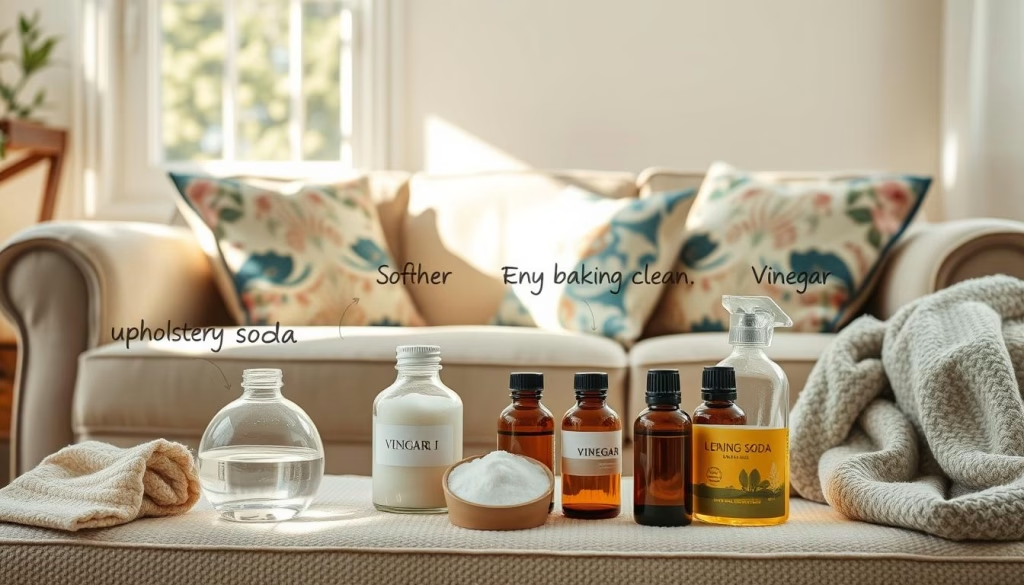
Professional Couch Cleaner vs DIY Methods: Cost Comparison
Keeping your couch clean and lasting longer can be done two ways: by hiring a couch cleaner or making your own furniture cleaner. Professional cleaners are convenient and skilled, but they cost more. DIY cleaning, on the other hand, can save you money, making it a good choice for those watching their budget.
Now, let’s look at how much each option costs:
| Cost Factor | Professional Cleaning | DIY Cleaning |
|---|---|---|
| Labor Charges | $50 – $150 per hour | Your time (often less than an hour) |
| Cleaning Products | Included in service cost | $5 – $20 for basic supplies |
| Transportation | Included in service cost | Your own travel |
| Total Cost (average) | $150 – $300 per couch | $5 – $20 per couch |
The table shows DIY couch cleaner can save you a lot of money, often 75% or more compared to hiring a pro. You can use cheap items like vinegar, baking soda, and essential oils to get good results without spending a lot.
Professional cleaners have the skills and tools for tough jobs or delicate fabrics. But for everyday upkeep or minor stains, making your own cleaner can be a smart and affordable choice.

Step-by-Step Guide to Deep Clean Your Sofa
Keeping your sofa clean is key. This guide will show you how to do it, from start to finish. You’ll learn how to make your couch look and feel new again.
Pre-Treatment Process
Start by vacuuming your sofa well. Focus on tight spots and hard-to-reach places. This gets rid of loose dirt, debris, and pet hair.
Then, use a sofa cleaner or couch shampoo on stains or busy spots. Let it sit for the time suggested before moving on.
Application Techniques
- Mix your sofa cleaner or couch shampoo with water, as the product says.
- Use a clean sponge or microfiber cloth to apply the solution to the sofa. Do it in small parts.
- Use a soft-bristled brush to work the solution into the sofa. This helps get rid of dirt and stains.
- Use a dry cloth to blot the area and soak up extra moisture.
Drying Methods
Let the sofa dry completely before using it again. To dry it faster, you can:
- Put a fan near the sofa to move air
- Open windows for better air flow
- Use towels or newspapers to soak up moisture
Follow these steps to deep clean your sofa. You can make it look like new again with simple sofa cleaner or couch shampoo methods.
Removing Common Stains with Household Items
Dealing with stubborn stains on your couch can be frustrating. But don’t worry! With a few simple household items, you can tackle tough spills. This guide will teach you how to become a stain-busting superhero, no matter the spill.
Food and Beverage Stains
For food and drink stains, mix warm water, dish soap, and white vinegar. Gently blot the stain with a clean cloth. Let the solution sit for a few minutes before blotting again. This mix of cleaners will lift the stain without harming the fabric.
Grease and Oil Stains
Grease and oil stains are tough, but baking soda is your secret weapon. Sprinkle baking soda over the stain and let it sit for 15-20 minutes. Then, vacuum it up. Baking soda absorbs the grease, leaving your couch clean.
Ink and Marker Stains
For ink and marker stains, use rubbing alcohol. Dampen a cloth with rubbing alcohol and gently blot the stain. The alcohol breaks down the ink, making it easier to remove. Always test the solution on a small area first to avoid damage.
Pet Stains
Pet accidents happen. To clean pet stains, mix equal parts white vinegar and water in a spray bottle. Spray the solution on the stain, let it sit, then blot with a clean cloth. The vinegar will neutralize the odor and lift the stain.
Acting quickly is key when dealing with stains. The sooner you tackle the problem, the better your chances of success. With these household remedies, you’ll keep your couch looking great.
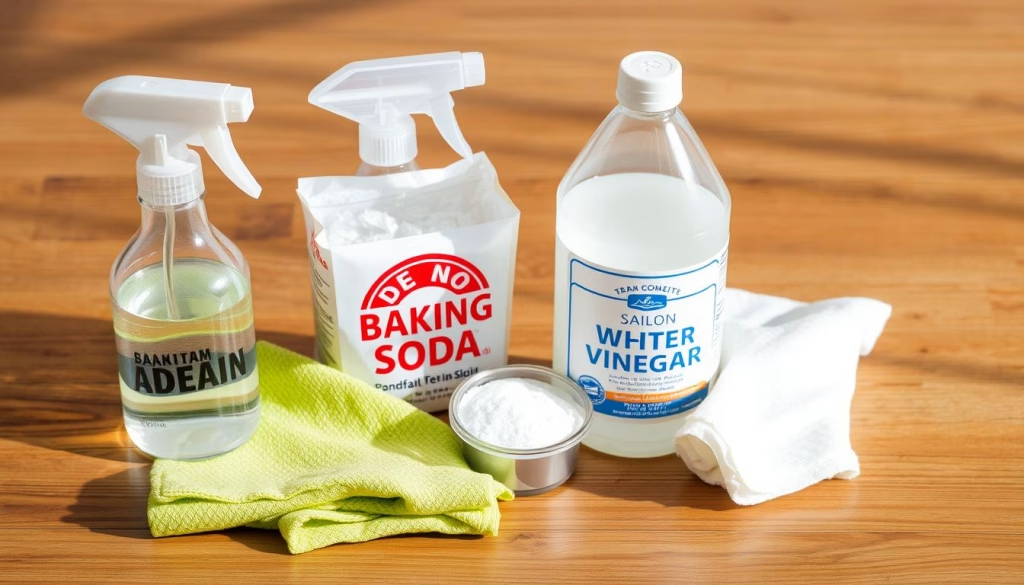
“Maintaining a clean and fresh-looking couch is essential for creating a comfortable and inviting living space.”
Best Practices for Using a DIY Fabric Cleaner
Using a homemade fabric cleaner needs careful steps for safe and good results. Let’s look at the main steps for cleaning your furniture with a DIY fabric cleaner or upholstery cleaner.
Spot Testing
Always do a spot test on a small, hidden area before cleaning the whole couch or chair. This checks if the DIY cleaner works well with the fabric and won’t harm it. Make sure to follow the fabric’s care label or ask a pro if you’re not sure.
Application Tools
- Use a soft-bristled brush or a clean, damp cloth to gently apply the fabric cleaner or upholstery cleaner to the surface.
- Avoid using abrasive scrubbing pads or sponges, as they can potentially harm the fabric.
- For hard-to-reach areas, consider using a small cleaning brush or a soft-tipped applicator to ensure even coverage.
Drying Time Management
It’s important to let the treated area dry properly when using a DIY fabric cleaner or upholstery cleaner. Make sure it’s fully dry before using the furniture or putting things on it. The drying time can range from 30 minutes to several hours, depending on the solution and fabric. Keep the furniture well-ventilated to avoid moisture problems.
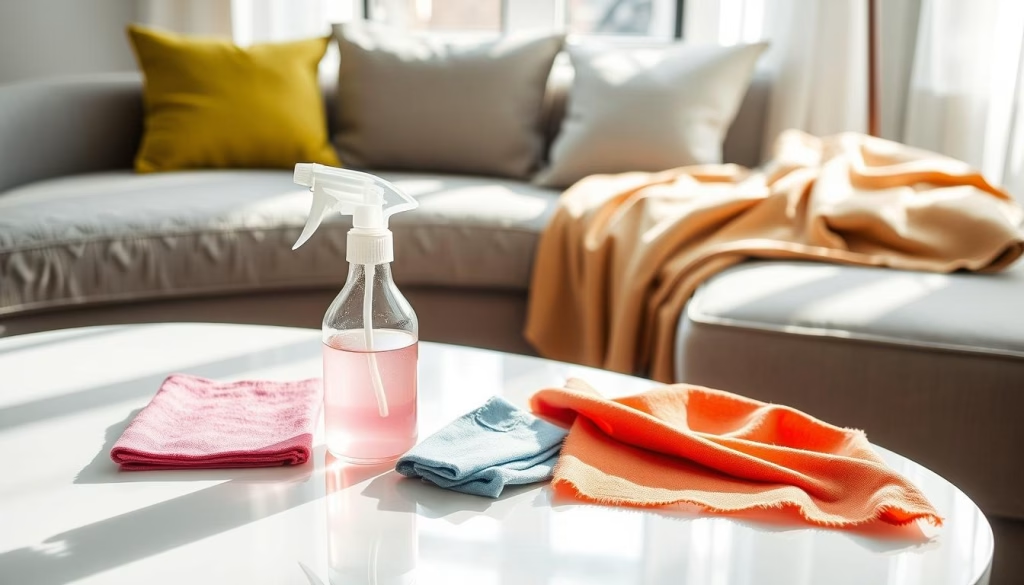
“Following best practices when using a DIY fabric cleaner will help ensure your upholstery remains in pristine condition.”
By following these tips, you can safely and effectively use a homemadefabric cleanerorupholstery cleanerto make your furniture look and feel great again.
Preventing Future Stains and Maintaining Your Couch
Keeping your couch clean and stain-free is easier than you think. A few simple steps can help you avoid deep cleaning. This way, your couch cleaner and furniture cleaner will work better.
Vacuuming regularly is key to a clean couch. Use the upholstery attachment to get rid of dirt, dust, and pet hair. Vacuum at least once a week, or more if you have pets or a busy home.
Think about using a couch protector spray. It creates a barrier against spills and stains. Just remember to test it on a small area first to avoid damage.
Changing your habits can also help prevent stains. Don’t eat or drink on the couch, and ask your family to do the same. If spills happen, clean them up right away with your couch cleaner or furniture cleaner.
Finally, rotate and flip your cushions often. This helps them wear evenly and keeps your couch looking great for longer.
Safe and Effective Couch Deodorizing Methods
Keeping your couch smelling fresh is key to a welcoming home. Commercial deodorizers might seem quick fixes, but they often have harsh chemicals. Luckily, there are many safe DIY ways to keep your couch smelling great.
Natural Deodorizers
Ingredients like baking soda, essential oils, and vinegar are great alternatives. Sprinkle baking soda on the fabric, wait a bit, then vacuum to get rid of odors. You can also make a natural air freshener by mixing water, vinegar, and essential oil in a spray bottle.
Long-lasting Freshness Tips
- Regularly vacuum and brush your couch to remove dirt, hair, and other debris that can cause odors.
- Spot clean any spills or stains as soon as they happen to prevent them from setting in and causing lingering smells.
- Rotate and flip your couch cushions periodically to ensure even wear and distribution of oils and odors.
- Consider investing in a couch cover or slipcover to protect your upholstery and make deep cleaning easier.
Using these natural methods and simple care tips will keep your couch deodorizer and upholstery cleaner smelling fresh for years.
Troubleshooting Common DIY Cleaning Mistakes
Starting a DIY couch cleaning project can be rewarding. But, it’s key to avoid common mistakes that can ruin your work. As a professional copywriting journalist, I’ve put together a guide to help you fix these issues. This way, your couch will look its best.
Avoiding Over-Wetting the Fabric
One big mistake in DIY couch cleaning is over-wetting the fabric. Too much water can cause mold, mildew, and damage the upholstery. To avoid this, always use the right amount of cleaning solution. Also, blot the area well with a clean, dry cloth.
Selecting the Right Cleaning Agents
Choosing the wrong cleaning agents can harm your couch’s fabric. Some products might be too strong, causing color changes or damaging the fibers. Always check the fabric type and pick a couch cleaner or fabric cleaner made for it.
Improper Drying Techniques
Not drying your couch properly can also cause issues. If it’s not dry, you might get musty smells, mildew, and harmful bacteria. Make sure to dry it as recommended. Use fans or let it air dry in a well-ventilated area.
Addressing Stubborn Stains
Some stains can be hard to get rid of, even with DIY cleaning. If you find a tough stain, don’t scrub hard. This can damage the fabric more. Instead, try a gentle spot-cleaning solution or get help from a professional couch cleaner.
By knowing these common mistakes and following best practices, your DIY couch cleaning will succeed. With the right steps, your sofa will stay fresh and welcoming for many years.
Pet-Safe DIY Cleaning Solutions for Furniture
Keeping your furniture clean while protecting your pets is important. You can make safe cleaning solutions at home. These natural formulas remove stains and odors without using harsh chemicals.
Begin by mixing white vinegar and water in a spray bottle. Vinegar’s acidity helps break down pet messes. The water makes the solution gentle yet effective. Adding a few drops of lavender or lemongrass essential oil gives it a fresh scent.
Baking soda is also great for pet-safe cleaning. Sprinkle it on the stain, wait a few minutes, then scrub with a damp cloth. Baking soda gently removes stains without damaging fabrics or harming pets. Finish with a clean, damp cloth to wipe away any leftover baking soda.
FAQ
What are the benefits of using a homemade couch cleaner?
Homemade couch cleaners are cost-effective and eco-friendly. They let you target specific stains and odors. You can make your own using common household items.
How do I determine the right cleaning method for my couch fabric?
The right cleaning method depends on your couch’s fabric. Always check the care label. Some fabrics need special care to avoid damage.
What are some essential ingredients for a homemade couch cleaner?
You can use white vinegar, baking soda, and essential oils to clean your couch. These natural ingredients remove stains, deodorize, and refresh the fabric.
How do I deep clean my couch using a homemade solution?
Start by pre-treating your couch. Then, apply the homemade solution. Make sure it dries completely to avoid moisture issues.
How can I remove specific stains from my couch using household items?
For different stains, use items like club soda, dish soap, or hydrogen peroxide. They work well on spills, ink, and pet accidents.
What are some best practices for using a DIY fabric cleaner on my couch?
Always test the solution first. Use the right tools and manage drying times to protect your couch’s fabric.
How can I prevent future stains and maintain the cleanliness of my couch?
Regular maintenance and protective treatments are key. Vacuum, spot clean, and use covers or throws to protect the fabric.
What are some safe and effective methods for deodorizing my couch?
Use natural deodorizers like baking soda, essential oils, or vinegar. They eliminate odors without harsh chemicals.
How can I troubleshoot common mistakes when using a DIY couch cleaner?
Common mistakes include over-wetting and using the wrong agents. Adjust your approach and follow best practices to avoid these issues.
What are some pet-safe DIY cleaning solutions for my furniture?
Use non-toxic, pet-friendly ingredients like hydrogen peroxide, castile soap, or essential oils. They remove stains and odors safely for your pets.


